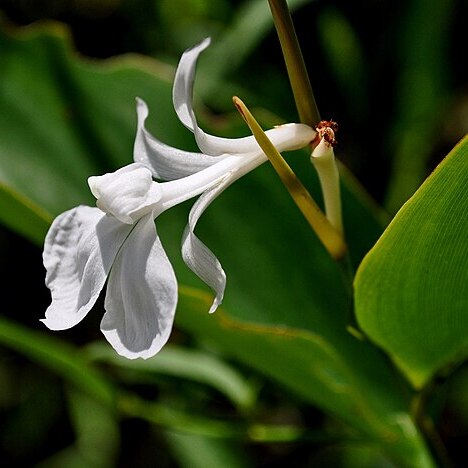Herbs 1.5--4(--5) m tall. Stems with basal, canelike internode 1--2.5 m. Leaf sheath to 15 cm; petiole 8--20 cm, thickened into a cylindric pulvinus; leaf blade broadly ovate to elliptic, 10--25 × 10--45 cm, abaxially villous along midvein, base rounded to obtuse, apex acuminate. Inflorescences often branched at base, to 20 cm, slender; bracts 9--11, green, obovate to lanceolate, 2.5--3.5 cm, deciduous after anthesis. Pedicel thickened in fruit. Sepals white, triangular-ovate, 3--3.5 mm, glabrous. Corolla tube 8--10 mm; lobes linear, 1--1.4 cm × 2--3 mm. Outer staminodes white, obovate, 1.2--1.4 cm × 5--6 mm; callose staminode yellowish, ca. 1.5 cm, apex usually emarginate; cucullate staminode light yellow at apex. Fertile stamen ca. 8 mm, with a narrowly triangular appendage. Ovary sericeous. Fruit white to pale cream, 1--1.5 cm in diam., dry, indehiscent. Seeds 1 or 2, brown, globose to complanate. Fl. Jun.
More
A half woody herb from 1 to 3 m high. It continues to grow from year to year. The bases of the branches are somewhat swollen. The stem is swollen near the nodes or joints. The stem branches 2 to 4 times. The base of the stem has cane like nodes. The leaves are usually rounded at the base and pointed at the tip. They are 15-30 cm long. The leaf bases are very long and wrap around the stem. This sheath can be 8-18 cm long. The flower spike develops in the axils of leaves. Sometimes it is unbranched can can be branched once or twice. It is 20-35 cm long. At each node of the flower stalk is an in-rolled sheath like bract. The flowers are white. The fruit are rounded and are about 1 cm across.
A tropical plant. It grows in damp soil. They are common and widely distributed in Papua New Guinea and the Philippines. In China they grow in wet places in secondary forest. In Sabah it grows up to 800-1,000 m altitude.

